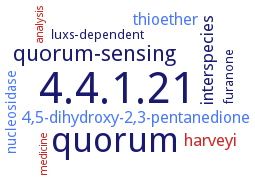4.4.1.21: S-ribosylhomocysteine lyase
This is an abbreviated version!
For detailed information about S-ribosylhomocysteine lyase, go to the full flat file.

Word Map on EC 4.4.1.21 
-
4.4.1.21
-
quorum
-
quorum-sensing
-
interspecies
-
harveyi
-
thioether
-
4,5-dihydroxy-2,3-pentanedione
-
nucleosidase
-
luxs-dependent
-
furanone
-
medicine
-
analysis
- 4.4.1.21
-
quorum
-
quorum-sensing
-
interspecies
- harveyi
- thioether
- 4,5-dihydroxy-2,3-pentanedione
- nucleosidase
-
luxs-dependent
-
furanone
- medicine
- analysis
Reaction
Synonyms
AI-2 synthase, autoinducer-2 synthase, BsLuxS, EC 3.13.1.2, EC 3.2.1.148, EC 3.3.1.3, EcLuxS, lsrR, Lux S, LuxS, LuxS protein, S-ribosyl homocysteinase, S-ribosylhomocysteinase, S-ribosylhomocysteine lyase, S-ribosylhomocysteinelyase, VhLuxS
ECTree
Advanced search results
Application
Application on EC 4.4.1.21 - S-ribosylhomocysteine lyase
Please wait a moment until all data is loaded. This message will disappear when all data is loaded.
analysis
-
rapid, selective, and sensitive liquid chromatography-tandem mass spectrometry assay for the simultaneous quantification of the metabolites and precursors of the activated methyl cycle. Analytes are extracted from Escherichia coli MG1655 and chemically derivatized as N(O,S)-iso-butyloxycarbonyl iso-butyl esters using iso-butyl chloroformate in an aqueous iso-butanol/pyridine environment. S-Adenosylmethionine, S-adenosylhomocysteine, S-ribosylhomocysteine, homocysteine, methionine, cystathionine, cysteine, and homoserine are quantified by liquid chromatography-positive ion tandem electrospray ionization mass spectrometry. Internal standards are isotopically labeled [13CD3]methionine and S-adenosylcysteine. Linearity of the assay is established up to a concentration of 700 microg/g cell dry weight for each analyte
medicine
autoinducer-2 promotes interspecies signaling, the autoinducer-3 activates enterohemorrhagic Escherichia coli virulence genes, knocking out luxS in the enterohemorrhagic human pathogen Escherichia coli reveals a defect in AI-3 production, but not in AI-2 production


 results (
results ( results (
results ( top
top






